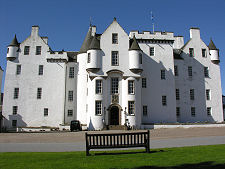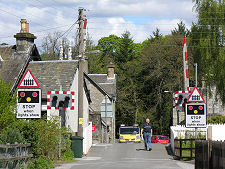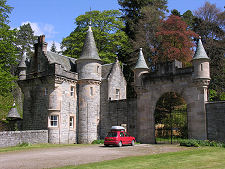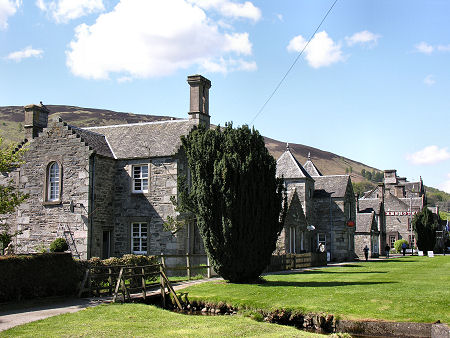 Blair Atholl with Tulach Hill in the Background |
Today's traveller through Glen Garry to the far north can stay on the A9, leaving Blair Atholl unseen except for a brief glimpse of Blair Castle, white against the dark green of a distant hillside. It was not always so. Until 1984 the main road north went through the village. The construction of the new road on the far side of the glen left Blair Atholl a much more peaceful place.
Blair Atholl is one of the prettiest inland villages in Scotland. The old main road north passes just outside the southern boundary wall of the estate of Blair Castle and the village stands a little back from the south side of the road, attractively built in uniform grey stone. The uniformity of appearance is no coincidence. Until 1823 very little except for a mill whose origins dated back to the 1590s stood within the area of the current village. Blair Atholl then grew rapidly as an estate village for the castle, and as new buildings were added they were built in a consistent style using locally quarried stone.
Until 1823 the main road along Glen Garry crossed the River Tilt over a bridge a mile upstream from its confluence with the River Garry, at what is now known as Old Bridge of Tilt. It then proceeded along the north side of the glen, passing to the north of Blair Castle through the village now known as Old Blair. This all changed in 1823 when the engineer John Mitchell, an associate of Thomas Telford, built a new bridge over the River Tilt as part of a new road being constructed along Glen Garry. The new road passed to the south of Blair Castle along the line followed by the A9 until 1984, a line which is still followed by the main road through Bridge of Tilt and Blair Atholl.
Development rapidly followed, with Blair Atholl Parish Church being built in 1824-5, the Atholl Arms Hotel in 1832 and a school (now the Atholl Country Life Museum) in 1833. Meanwhile estate cottages were also appearing in the new village. In effect, much of the activity previously focused in Old Blair simply relocated a mile south to the new Blair Atholl. One result was the falling into disuse of St Bride's Kirk, which served Old Blair and now stands as a ruin in the grounds of Blair Castle. The Bridge of Tilt Hotel was built to the east of the new bridge over the River Tilt in 1840.
In 1863 the village received an important boost with the arrival of the railway from Perth north to Inverness. With its Highland setting, good transport links, and available accommodation the village became a popular tourist destination. The Blair Atholl golf club was founded in 1892.
The modern village of Blair Atholl comprises two parts, one either side of the River Tilt. Best known is the stone estate village which occupies its western half, strung out along the main road and looking across it to the wall and gates of Blair Castle. Here you find most of the old stone buildings, the museum, the village hall, the Atholl Arms Hotel, the still working watermill, a caravan park, the post office and the railway station. Less well known (and actually rather larger) is the part of the village to the east of the Bridge of Tilt, home to the Bridge of Tilt Hotel, a shop, the Loft Restaurant, the golf club, another caravan park, and most of the village's housing.
Though not strictly part of Blair Atholl, another major attraction should be mentioned here, located north-west of the village, where the old road rejoins the "new" A9. Here you will find the strikingly constructed House of Bruar. This is in effect a shopping mall for luxury and high quality goods from Scotland and beyond. One story suggests that it was originally designed so it could be converted into a hotel if what must have seemed a rather adventurous retail proposition didn't work out: but its obvious success suggests there is little chance of that being necessary. A path leading uphill from the House of Bruar takes you to the spectacular Falls of Bruar.
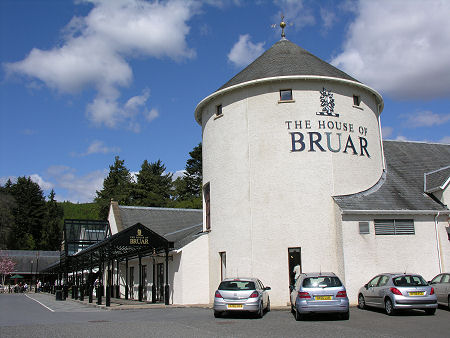 House of Bruar |

|
|
|
Visitor InformationView Location on MapWhat3Words Location: ///unsigned.fears.recorders |
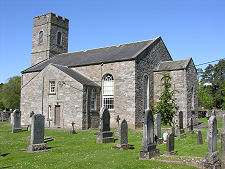 Blair Atholl Parish Church |
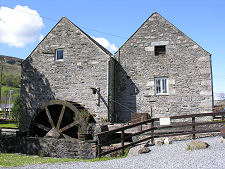 Blair Atholl Watermill |
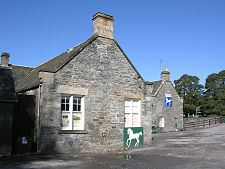 Atholl Country Life Museum |
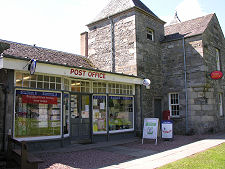 Blair Atholl Post Office |
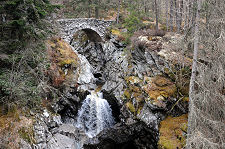 Falls of Bruar |
